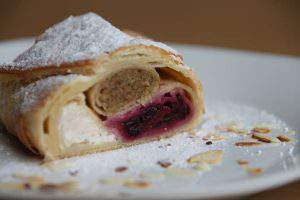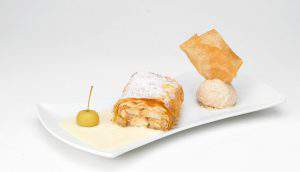Recipe of the week: Hungarian strudel (rétes)

The Viennese apple strudel is among the world’s 100 most famous foods. But where does this hearty dessert come from, and how do Hungarians make it? Nowadays we tend to do it the lazy way, not like our grandmothers who even made the pastry from scratch. We tried to find out their secret 🙂
In Hungarian we call the dessert rétes, which comes from réteges (layered), while the German strudel comes from swirl/ whirl. According to mindmegette.hu, rétes used to be a layered dessert baked in a furnace without filling. The stuffed version is known since the 17th century, and it spread in the Habsburg Empire in the 18th century. The first written document speaking about the dessert is from 1696, and it is kept in the Viennese Municipal Library.
The dessert is known as strudel all over the world, even though it is a traditional dish in almost all Central-Eastern European countries. For instance, it is called zavitek in Slovenia, závin in the Czech Republic, savijača or štrudla in Croatia, and gibanica in Serbia.

It is closely related to baklava and burek, which are the beloved delicacies of the Mediterranean, Turkish, Arab and Iranian cuisine. It is believed that the Turks introduced the dessert family in the 16th century. Today’s stuffed strudel was created in the Austro-Hungarian Empire in the 18th-19th century. It has been a traditional festive dessert in Hungary since then.
The Parisian Ritz Hotel featured the “rétes Hongrois” (Hungarian strudel) on its menu in the 19th century. They wanted it to be authentic so they ordered pastry flour from Hungary and even sent their confectioners to learn some tricks in Pest. We don’t know whether or not they succeeded, but we do know who to turn to for the secret: grandmas or elderly ladies who still know the tricks of making strudel pastry.

If you like challenges and having fun in the kitchen, you should definitely try to make it at home. It all comes down the flour, which has to be lighter than normal flour and has to be high in gluten. Regarding the filling, you can basically use anything. You can make a filling out of everything, just make sure to use some ground nuts or wheatmeal in the case of juicy fruits.
A few filling options:
- cottage cheese filling: cottage cheese, sour cream, egg, sugar, possibly vanilla sugar, zest of lemon/ lemon juice, raisins, wheatmeal;
- poppy seed filling: ground poppy seeds and sugar scalded with milk, spiced with cinnamon/ lemon zest/ orange zest etc. or mixed with apricot jam/ grated apple;
- apple filling: grated and steamed apple (sour type) mixed with sugar, raisins, ground walnut, cinnamon;
- sour cherry filling: pitted sour cherry with ground walnut and cinnamon
- pumpkin-poppy seed filling: ground poppy seed mixed with sugar and grated pumpkin or squash;
- walnut-plum filling: quartered plum mixed with ground walnut and cinnamon sugar.

These are only a few options, you could even use savoury fillings or basically anything you’d like. The recipe variations are endless, it is all up to you how you want to mix and match the flavours 🙂
Now comes the fun part: the homemade pastry. According to pekszovetseg.hu, you’re going to need 500 grams of good quality pastry flour, two tablespoons of fat (plus some more here and there), one egg, 2.5 dl of water, a teaspoon of vinegar and a pinch of salt. Moreover, you’re going to need a big table and patience.
Heat up the water until it becomes lukewarm and add the salt and the vinegar. Sieve the flour onto a flat surface, add the egg and half of the fat, and start mixing with your hands. Slowly start adding the water mixture while constantly kneading the dough until you reach a soft consistency with bubbles forming on the surface of the dough. Also, it shouldn’t stick to your hand, nor the surface.
Separate he dough into two loaves, cover them with the rest of the fat, put them into two separate bowls, and let them raise in a warm place. It should double in size and become even lighter. Meanwhile, you can prepare your table. Put a table cloth onto the table and spread some flour on the cloth.
After the dough has raised, flat it with a rolling pin in the middle of the table. Then, slowly start pulling it outwards with floury hands – mainly the back of your hand – while going around the table. You need to do this carefully until the pastry becomes paper thin (you should be able to read a magazine through it). Tear off thicker edges, and let the pastry cool off.

After it has cooled off, spread some fat/oil/butter over the pastry, and fold it with the help of the table cloth. Butter it after every fold. When you’ve reached a normal rectangular size, add the filling. Make sure to add something that absorbs juice in the case of fruits (ground nuts, wheatmeal etc.). Juicy fillings are usually placed in the centre of the pastry, while other fillings are spread evenly over the pastry.
Roll up your rétes with the help of the table cloth, and grease the top with some fat/oil/butter. Cut it in a way that you can fit the loaves into a greased baking tin. Bake it at 180-200° Celsius until golden and crunchy. Let it cool for a while, then cut it up diagonally (~4 cm pieces). Sprinkle some powdered sugar or vanilla sugar on top.
Enjoy!
Featured image: www.facebook.com/GerbeaudCafé
Ce: bm
Source: Daily News Hungary






How about a recipe for cottage cheese strudel.